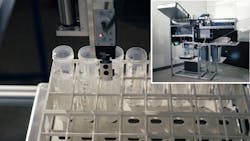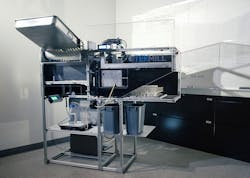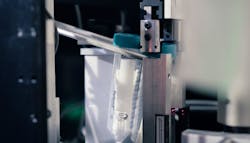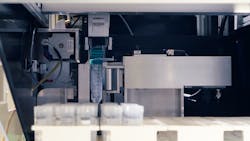Redesigning a Test-Tube Handler for Robot-Based COVID Testing
When the COVID-19 pandemic struck last year, the demand for fast and accurate testing of patients’ nasal-swab samples skyrocketed, with some labs going from needing 10,000 swabs checked daily to more than 100,000. To meet that rising demand, engineers at Tekmill and Festo redesigned one of Tekmill’s automated robotic machines that handles 50-ml test tubes of agricultural samples and places them in a rack while they waited to be tested. They coupled the updated machine with a new approach to testing to come up with a system that could handle 100,000 samples per day.
Up until this time, a patient’s nasal swab would be sealed in a test tube for processing at a screening laboratory, where it underwent the Center for Disease Control’s (CDC) protocols for reverse transcription quantitative polymerase chain reaction (RT-qPCR) testing. At the lab, the test tube’s cap is removed, reagents are added, and the samples undergo a series of lab processes that determine whether the swab is positive or negative for COVID-19.
Designers knew the one-sample-per-test-tube approach needed to be changed to get to high-volume testing. Not only does the one-swab approach create a mountain of backlog when demand rises so steeply, it eats up incredible amounts of consumables—reagent, test tubes and caps—which are costly and quickly became hard to come by in such large volumes.
To sidestep these hurdles, labs adopted pool processing. In this approach swabs from several patients are placed in a single test tube and processed as a single diagnostic sample. If the multi-swab test tube—say, a group of 10 people—is negative, no action is required and they are all counted as negative. If, on the other hand, the tube tests positive, then only those 10 individuals need to go through the more expensive but useful rapid testing that identifies positive results in under 30 min.
Using the example of 10 swabs per test tube, 10,000 tubes can be analyzed per day, effectively screening 100,000 people for COVID-19 daily. Pool processing also cuts the use of consumables by about 90%. Handling 10,000 test tubes per day is significantly easier than handling 100,000 tubes, but it is still a challenge for labs. To streamline the process further, automation and robotics needed to be applied. This is where Tekmill’s and Festo’s expertise was brought to bear.
Tekmill, a contract design and fabrication company located at the University of Illinois in Research Park had already developed an automated 50-ml conical centrifuge tube handler for decapping, adding reagent, recapping and placing the 50-ml tubes into a standard test-tube rack of 24 tubes. It freed up skilled lab workers who would otherwise spend hours manually taking caps off, pipetting reagent, placing caps back on and then racking thousands of 50-ml tubes.
The machine was reliable and fast, with a throughput of over five tubes per minute. It delivered reagents with an accuracy of ±3% error for volumes less than 3 ml. The device included a temperature-controlled reagent compartment, quick change-and-clean features, a peristaltic-based pump for sterility and accuracy, and a display screen-based user interface.
The automated machine was compact and could be easily wheeled to where it was needed. It was also flexible, thanks to the EXCM mini-gantry robot from Festo, a global company that designs electrical and pneumatic automation equipment. The gantry robot raised the cap as the test tube was spun, lowered the cap as the tube rotated the opposite way after filling and then placed the test tube in the rack. The robot could easily be reprogramed as conditions changed.
The first step in pooled testing is decapping the tubes and accurately adding reagent. The Tekmill machine could already do this, but not at the targeted rate of 10,000 tubes per day. With support from Festo, Tekmill electrical and mechanical engineers began a rapid redesign to revamp the machine’s robotic gantry.
One of the first tasks was to redesign the cap handling. In the original machine, a test tube was rotated while the Z-axis on the mini-gantry robot used its parallel gripper to hold the cap as it came off the test tube, and later held and lowered it as the tube swiveled closed. After the redesign, the robot no longer removed the cap, added reagents and then put the cap back on. Instead, it removed the cap, dropped it into a newly added disposal bin and then added reagent.
Although machine vision and barcode reading and tracking were not required on the original redesign of the machine, Tekmill engineers wisely planned for this upgrade should it ever be needed. This pre-planning saved time and effort when a vision subsystem and barcode reading were added to the pooled testing machine to track samples and lower the risk of errors. Fluid handling in the original machine migrated seamlessly to the new one, including the benefits of keeping the reagent sterile by using a peristaltic pump.
During testing of the new machine, dubbed the COF-CTV, it was noted that some tubes arriving to be capped were over-torqued to the point that the caps could not be removed without damaging them. Tekmill installed torque sensors to identify over-torquing. When offending tubes are encountered, the mini gantry moves them to a bin designated for manual opening. This preserves the integrity of the 10 samples in the offending tube while maintaining the speed of the other tubes through the unit.
Tekmill engineers also increased the per-load capacity to more than 400 test tubes, which means it only needs to be loaded once per hour, an efficient use of lab staff. The flexibility of the EXCM mini-gantry robot made this transition in speed and quantity a matter of programming. Overall, the upgrades increased throughput from old to new machine by about 20%.
Running around the clock, each
CTF-COV tube-handler makes it possible to process 100,000 COVID-19 tests per day using pool testing, a clear demonstration of the power of robotics to increase throughput in today’s automated labs.
Take a look at Tekmill’s robotic sample tube handler in action below:
Matthew Durack is general manager and VP of engineering at Tekmill, and Sebastian Baran is a sales engineer at Festo.




